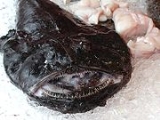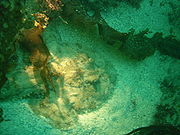
Lophius
Encyclopedia


Europe
Europe is, by convention, one of the world's seven continents. Comprising the westernmost peninsula of Eurasia, Europe is generally 'divided' from Asia to its east by the watershed divides of the Ural and Caucasus Mountains, the Ural River, the Caspian and Black Seas, and the waterways connecting...
generally, the grotesque shape of its body and its singular habits having attracted the attention of naturalists of all ages. To the North Sea
North Sea
In the southwest, beyond the Straits of Dover, the North Sea becomes the English Channel connecting to the Atlantic Ocean. In the east, it connects to the Baltic Sea via the Skagerrak and Kattegat, narrow straits that separate Denmark from Norway and Sweden respectively...
fishermen this fish is known as the "monk," or "monkfish
Monkfish
Monkfish is the English name of a number of types of fish in the northwest Atlantic, most notably the species of the anglerfish genus Lophius and the angelshark genus Squatina...
", a name which also belongs to Squatina squatina, the angelshark, a fish allied to the skate
Skate
Skates are cartilaginous fish belonging to the family Rajidae in the superorder Batoidea of rays. There are more than 200 described species in 27 genera. There are two subfamilies, Rajinae and Arhynchobatinae ....
s (see monkfish
Monkfish
Monkfish is the English name of a number of types of fish in the northwest Atlantic, most notably the species of the anglerfish genus Lophius and the angelshark genus Squatina...
for discussion). The north European species is L. piscatorius, the Mediterranean species L. budegassa.
The head is of enormous size, broad, flat and depressed, the remainder of the body appearing merely like an appendage. The wide mouth extends all round the anterior circumference of the head; and both jaws are armed with bands of long pointed teeth, which are inclined inwards, and can be temporarily depressed so as to offer no impediment to an object gliding towards the stomach, while still preventing its escape from the mouth. The pectoral and ventral fins are so articulated as to perform the functions of feet, the fish being enabled "walk" on the bottom of the sea, where it generally hides itself in the sand or amongst seaweed. All round its head and also along the body, the skin bears fringed appendages resembling short fronds of seaweed. These structures, combined with the ability to change the colour of the body to match its surroundings, assists the fish greatly in concealing itself in its lurking places, which are selected for their abundance of prey.
Lophius sp. have three long filaments sprouting from the middle of its head; these are the detached and modified three first spines of the anterior dorsal fin. As with all anglerfish species, the longest filament is the first, which terminates in an irregular growth of flesh, the esca, and is movable in all directions; this modified fin ray is used as a lure to attract other fishes, which the monkfish then seizes with its enormous jaws, devouring them whole. Experiments have shown, however, that whether the prey has been attracted to the lure or not is not strictly relevant, as the action of the jaws is an automatic reflex triggered by contact with the esca.
Monkfish, like most anglerfish are also characterised by an enormously distensible stomach, which allows an individual monkfish to swallow prey fully as large as itself. Monkfish grow to a length of more than 150 cm (4.9 ft); specimens of 100 cm (3.3 ft) are common.
The spawn of this genus is very remarkable. It consists of a thin sheet of transparent gelatinous material 60–100 cm (2–3.3 ft) wide and 8–10 m (26.2–32.8 ft) in length. The eggs in this sheet are in a single layer, each in its own little cavity. The spawn is free in the sea. The larvae are free-swimming and have the pelvic fins with elongated filaments.
The East Atlantic species is found all round the coasts of Europe but becomes scarce beyond 60° N. latitude; it occurs also on the coasts of the Cape of Good Hope
Cape of Good Hope
The Cape of Good Hope is a rocky headland on the Atlantic coast of the Cape Peninsula, South Africa.There is a misconception that the Cape of Good Hope is the southern tip of Africa, because it was once believed to be the dividing point between the Atlantic and Indian Oceans. In fact, the...
. The species caught on the North America
North America
North America is a continent wholly within the Northern Hemisphere and almost wholly within the Western Hemisphere. It is also considered a northern subcontinent of the Americas...
n side of the Atlantic is usually Lophius americanus
Lophius americanus
Lophius americanus is a monkfish in the family Lophiidae, also called goosefish, American anglerfish, all-mouth or fishing frog. It is native to the eastern coast of North America...
. A third species (Lophius budegassa), inhabits the Mediterranean, and a fourth (L. setigerus) the coasts of China
China
Chinese civilization may refer to:* China for more general discussion of the country.* Chinese culture* Greater China, the transnational community of ethnic Chinese.* History of China* Sinosphere, the area historically affected by Chinese culture...
and Japan
Japan
Japan is an island nation in East Asia. Located in the Pacific Ocean, it lies to the east of the Sea of Japan, China, North Korea, South Korea and Russia, stretching from the Sea of Okhotsk in the north to the East China Sea and Taiwan in the south...
.
There is concern over the sustainability of Monkfish fishing. The method most commonly used to catch monkfish, beam trawling
Bottom trawling
Bottom trawling is trawling along the sea floor. It is also often referred to as "dragging".The scientific community divides bottom trawling into benthic trawling and demersal trawling...
, has been described as damaging to seafloor habitats. In February 2007, the British supermarket chain Asda
Asda
Asda Stores Ltd is a British supermarket chain which retails food, clothing, general merchandise, toys and financial services. It also has a mobile telephone network, , Asda Mobile...
banned monkfish from their stores.
External links
- The Compleat Lophius
- Monkfish facts, Maryland Department of Natural Resources
- NOAA Monkfish Research Program
Note
This article overlaps / duplicates (well, in spirit, but not in content) with the article on monkfishMonkfish
Monkfish is the English name of a number of types of fish in the northwest Atlantic, most notably the species of the anglerfish genus Lophius and the angelshark genus Squatina...
. The other article should be merged into this one.

